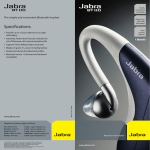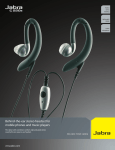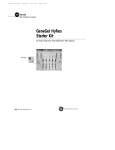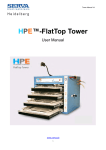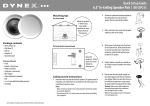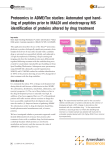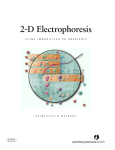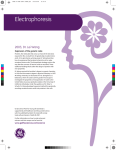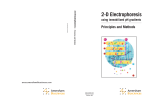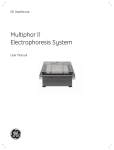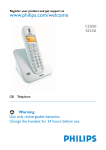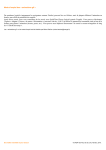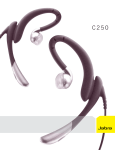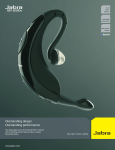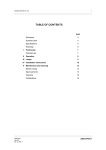Download DNA Silver Staining Kit - GE Healthcare Life Sciences
Transcript
A M E R S H A M B I O S C I E N C E S DNA Silver Staining Kit Instructions 70-5006-88 Edition AA 1. Introduction 1. Introduction PlusOne™ DNA Silver Staining Kit kit contains all essential components for staining of nucleic acids in polyacrylamide gels. To avoid transportation of large solution volumes, most of the solutions are in a 5× concentrated form, ready to use after a simple dilution. The high sensitivity of the visualization technique allows detection of nucleic acids down to 20–50 pg DNA/band. The method is reliable and reproducible and gives a gel with distinct bands on an essentially colourless background ready for drying and/or evaluation in about 1.5 h. The formulation of the kit* minimizes production of toxic waste and optimizes sensitivity and robustness making the kit especially suitable for use in automatic staining equipment: Hoefer® Automated Gel Stainer and GeneStain™ Automated Gel Stainer. In additon, the kit also provides the method of choice for standard manual silver staining of DNA in polyacrylamide gels. The kit performs best on 0.5–1.0 mm thick plastic-backed gels, or 0.75–1.5 mm thick un-backed gels. The procedure described in this instruction is based upon the use of 125 ml solution per process step. Each kit contains material for 20 processes. When using the 125 ml tray in Hoefer Automated Gel Stainer or GeneStain Automated Gel Stainer this gives the following processing capacity for different gel sizes: Gel Size Gels/process Gels/kit 7x8 cm (SE250 minigels) 14x16 (SE 600 type) 12.5x26 cm (ExcelGel, CleanGel) 11 x12.3 cm (GeneGel) 1–4 1 1 2 80 20 20 40 * Patent pending Hoefer‚ ExcelGel‚ Multiphor, GeneStain, CleanGel, GeneGel, Red Rotor, PlusOne and its logo are registered trade marks owned by Amersham Biosciences. 2 2. Kit contents and technical data 2. Kit contents and technical data Kit contents DNA Silver Staining Kit (Code No. 17-6000-30) contains the following items: Item Composition Quantity Benzene sulphonic acid; 3.0%w/v in 24%v/v ethanol 500 ml Silver nitrate; 1.0%w/v Benzene sulphonic acid; 0.35%w/v 500 ml Sodium carbonate solution, 5× Sodium carbonate; 12.5%w/v 500 ml Formaldehyde; 37% Sodium thiosulphate; 2% Formaldehyde; 37%w/v in water Sodium thiosulphate; 2%w/v in water 4 ml 4 ml Acetic acid, 5%v/v Sodium acetate; 25%w/v Glycerol; 50%v/v 500 ml Booklet Laminated sheet 1 1 Fixing solution, 5× Staining solution, 5× Stopping & Preserving solution, 5× Instructions Short instructions 3 2. Kit contents and technical data When used in Hoefer Automated Gel Stainer or GeneStain Automated Gel Stainer the Kit content is sufficient for staining 20 standard size gels (14×16 cm or 12×24 cm) or 80 minigels (7×8 cm). Technical data Sensitivity: 20-50pg DNA per band Usage temperature: +20 to +27 °C Storage: +10 to +30 °C Shelf life: 1 year at recommended storage conditions Precautions: The chemicals in this kit should not be discarded via public waste water systems. Please dispose of these chemicals properly. We recommend that you collect and dispose of the silver containg waste separately. Consult your local regulations for more information. Read the warning text on the label of each bottle. 4 3. Protocol and procedure for silver staining 3. Protocol and procedure for silver staining General information This protocol is optimized for precast GeneGel, CleanGel and ExcelGel media from Amersham Biosciences, but will also work on most other gel types. When used in Hoefer Automated Gel Stainer or GeneStain Automated Gel Stainer instruments the protocol will provide excellent results for gels in sizes from 7×8 cm up to 18×24,5 cm (ExcelGel SDS 12-14) in thicknesses of 0.75–1.5 mm for unbacked gels and 0.5–1.0 mm plasticbacked gels. Gels outside of these dimensions may require modified procedures. All procedures are based on all reagents used at a temperature of +20 to +27 °C. Using reagents outside this temperature range will require modification of development times for optimal results. If the temperature is below 20 °C, extend the development time to 8–10 min. If the temperature is above 27 °C, reduce development time to 4 min. For manual use we recommend gentle shaking in all steps on an automated shaker like Red Rotor Orbital Shaker equipped with Staining Tray 1 or Staining Tray 2 (see Recommended Equipment and Accessories, p. 10). These trays have polished surfaces of SIS 2332 grade stainless steel that do not interfere with the silver staining technique. For maximal convenience and reliability we recommend automated staining in programmable Hoefer Automated Gel Stainer or GeneStain Automated Gel Stainer with preset programs. 5 3. Protocol and procedure for silver staining Chemicals required: • Chemicals included in the DNA Silver Staining Kit, plus: • Ethanol (24%) (Prepare in advance) • Distilled or deionized water Equipment required: • • • • Five Reagent vessels taking 125 ml solution Measuring cylinders; 25 and 100 ml Micropipette for delivering 125 ml Automated staining equipment or Staining tray (preferably stainless steel) and rotating table for manual staining • Bottles Reagent preparation For staining volumes of 125 ml, prepare the 5 reagents listed below in clean glass bottles. Adjust component volumes appropriately if staining in volumes other than 125 ml. Reagent 1. Fixing solution 2. Staining solution 3. Developing solution 4. Stopping & Preserving solution 5. Water for washing Components required from Kit 25 ml Fixing solution, 5× 25 ml Staining solution, 5× 25 ml Sodium carbonate, 5× 125 µl Sodium thiosulphate 125 µl Formaldehyde* 25 ml Stopping & Preserving solution, 5× Other components 100 ml 24% ethanol 100 ml water 100 ml of water 100 ml water > 125 ml * IMPORTANT: The Developing solution with formaldehyde is very unstable and should be prepared immediately before use. When performing the staining in any of the automated gel stainers, it should be prepared as the last step before starting the staining process. Please also note that the cloudy precipitate of polymerised formaldehyde that sometimes develops during normal storage does not affect staining performance. 6 3. Protocol and procedure for silver staining Automated staining procedure: Automated staining in Hoefer Automated Gelstainer or GeneStain Automated Gel Stainer. 1. Attach the staining reagent bottles to IN-ports and the waste bottles to OUT-ports according to the Table below. Make sure the suction pipes penetrate down to the bottom of the vessels to allow all reagent solution to be taken up. 2. Make sure all solutions are at the proper temperature (+20 to +27 °C). 3. Position the gel(s) in the staining tray with or without the aid of the magnets. 4. Choose the pre-programmed DNA Silver Staining protocol. 5. Start the protocol 6. Retrieve the stained gel after ca 1.5 h Table 1: Hoefer Automated GelStainer Protocol #1: DNA Silver Stain Step Solution IN-port OUT-port Processing step time 1 2 3 4 5 Fixing solution Silver solution Water (washing) Developing solution Stopping & Preserving solution 1 3 0 4 5 8 9 7 8 7 30 min 30 min 1 min 6 min 30 min & hold Table 2: GeneStain Automated GelStainer: DNA Silver Staining protocol Step Solution IN-port OUT-port Processing step time 1 2 3 4 5 Fixing solution Silver solution Water (washing) Developing solution Stopping & Preserving solution 1 2 0 3 4 5 6 7 8 9 30 min 30 min 1 min 6 min 30 min & hold 7 3. Protocol and procedure for silver staining Manual staining procedure 1. Make sure that the temperature of the reagents are within the range of +20 to+27 °C. If not, adjust the temperature or modify the reaction times for the corresponding steps (see ”General Information” p.5). 2. Use gloves and perform all steps with gentle shaking of the staining tray. 3. Be careful that the gel is evenly wetted with the entire solution volume during all process steps. Procedure: Process step Procedure Time 1 Fixing Soak the gel in fix solution 30 min (or longer, over night OK) 2 Silver impregnation Replace fixing solution with silver solution. Incubate 30 min 3 Washing Pour off silver solution. Add water 1 min 4 Development Pour off water Add Developing solution 6 min Soak gel in Stopping & Preserving solution At least 30 min (Over night OK) 5 8 Stopping & preserving 4. Troubleshooting guide 4. Troubleshooting guide This Troubleshooting Guide is primarily for manual staining but most parts are also relevant for automated staining. For more comprehensive information on staining, please consult Protocol Guide 80-6343-34 ”Automated Silver and Coomassie Staining of Polyacrylamide Gels”. For problems when using automated staining, please also consult the User Manual for the relevant instrument. Problem Cause Remedy Bands do not develop Temperature of reagent solution too low Keep temperature of solution between 20 and 27 °C Gel not washed thoroughly enough Repeat the washing procedure Did not fix properly Check fixing solution or fixing properties of your particular nucleic acid(s) Protein samples contaning reducing agents have been run on the gel(s) Run and stain DNA samples separately Too long exposure to developing solution Use no more than 10–15 minutes for development of bands at 21 to 25 °C Metal from magnets contaminating reagent solutions (Automated staining only) Exchange magnets with damaged coating Water impure Use distilled or deionized water Insufficient washing with water Extend the time of washing after staining Dirty tray Replace the chamber for development with a new clean one Insufficient shaking During the development step, shake the tray sufficiently to prevent the gel from sticking to the bottom of the tray Gels left in fix for too long Reduce fixing time: A minimum of 30 min required. Over night fixing usually OK. Background is excessively dark (over-developed) Silver mirror reaction Gels come loose from backing 9 5. Recommended equipment and accessories 5. Recommended equipment and accessories Product Code No. Hoefer‚ Automated Gel Stainer, V V V V 80-6330-04 80-6330-23 80-6330-42 80-6344-67 Red Rotor Orbital Shaker, 25X35 cm 115 V 80-6096-91 230 V 80-6097-10 115 V 80-6098-05 230 V 80-6098-24 , GeneStain Automated Gel Stainer, , - ” - 230 115 230 115 , 50X50 cm Staining Tray 1 with lid and removable gel holder (60x150x300 mm) Staining Tray 2 with lid (60x260x320 mm) Cellophane Sheets 10 18-1018-08 18-1018-09 80-1129-38 6. Precast gels and related products 7. Literature 6. Precast gels and related products GenePhor gel media kits Code No. GeneGel Excel 12.5/24 Kit GeneGel Clean 15/24 Kit 17-6000-14 17-6000-13 Multiphor II gel media kits ExcelGel DNA Analysis Kit DNA Fragment Analysis Kit 17-1198-07 17-1198-06 CleanGel™media for Multiphor II CleanGel 25S CleanGel 36S CleanGel 48S GelPool for rehydrating the gel PaperPool for soaking electrode strips 18-1031-54 18-1031-55 18-1031-56 18-1031-58 18-1031-59 DNA Molecular weight markers Product name øX174-Hinc II digest øX174-Hae III digest λ-Hind III digest λ-Hind III/øX174-Hinc II digest λ-Hind III/øX174-Hae III digest DRIgest III (lyophilized) Size range (bp) 79–1,049 72–1,342 2,027–23,130 79–23,130 72–23,130 72–23,130 Code No 27-4040-01 27-4044-01 27-4048-01 27-4052-01 27-4054-01 27-4060-01 7. Literature Protocol Guide ”Automated Silver and Coomassie Straining of Polyacrylamide Gels” Code No 80-6343-34. 11 Printed in Sweden by Wikströms, Uppsala 961209, July 1996













